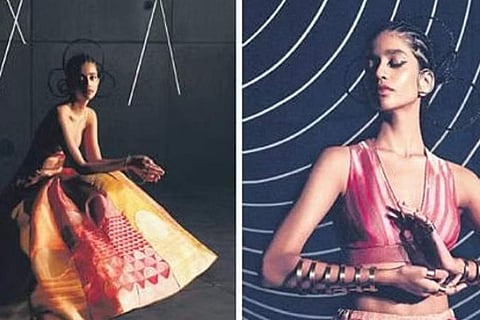
- LIFESTYLE
- FASHION
- FOOD
- ENTERTAINMENT
- EVENTS
- CULTURE
- VIDEOS
- WEB STORIES
- GALLERIES
- GADGETS
- CAR & BIKE
- SOCIETY
- TRAVEL
- NORTH EAST
- INDULGE CONNECT

Remember your grandmother’s pure zari Banarasi sari? The intricate motifs, the resplendent sheen, the caressing touch? Or your mother’s heavily worked tanchoi? That delicate all-over weave in the softest of silks and the purest of zaris? All of which evoke emotions of a lost time and age. Which is exactly what brother-sister duo, Amrit and Khushi Shah, are trying to revive with Shanti Banaras. Appropriately, it’s named after their grandmother, who, they say, epitomises all that the brand stands for. Their store, which opened in Varanasi in 2019, made its way to the nation’s capital in December 2021, and is now regarded as the place to go if you want the real deal.
So what sets Shanti Banaras apart from the clutch of other Banarasi brands in the market? “The fact that we house real zari saris, and a large variety at that. There are hardly any brands in the industry that handle real zari. Even a handful of brands that do, boast hardly a dozen or so in their collection. At our store, at any given time, you will find over 100 real zari saris. That’s because we want to bring back the luxurious weave for today’s women to experience,” says creative director Khushi, who works with almost 1,800 weavers for her unique handspun pure gold and silver saris and dupattas.
Unique and inventive are the keywords here. Take, for instance, just last month, Khushi channelled the modern master SH Raza, famous for his artworks around the ‘Bindu’, into her saris. “We wanted to fuse modern art with our traditional motifs and techniques.
As a family, we have admired and followed Raza’s works for a long time, so it was about implementing those geometrics and his whole idea about how he created the ‘Bindu’ into our collection,” says Khushi, adding, “We wanted to break out of the notion that we do only traditional motifs and show that our work ethos also comprises modernity. We are also channelling how Raza used upright and inverted triangles to convey the concept of dual male and female—prakriti and purush. We tried to play with all these concepts for the collection.” Making use of rangkat—a crossover of yarns with colour-blocking in stripes—and organza, the collection uses vibrant colours like a striking yellow or a popping orange.
No stranger to textile and weaving, the Shah family’s interest in handloom goes back over seven decades. But that did not mean the siblings had it easy when setting up their first outlet in Varanasi.
“The biggest challenge was going against the flow,” Khushi recalls. In a world where designers were coming up with newer versions and designs for the sari, going back to roots was a tough call, but they were determined. “We reintroduced the concept of resham. Where other brands were doing sequins, we aimed to revive the world of silken, and pure gold and silver threads,” she adds.
Little wonder that the brand, last year, also stepped into conserving the dying craft of hand-embroidered tapestries via Pichwai artworks, Rajasthan’s 400-year-old art tradition. While hand-painted Pichwai is still done by a few artists, the hand-embroidered version is fast vanishing.
In an effort to preserve this craft and make it accessible globally, Shanti Banaras has brought the exquisitely embroidered artwork to its showroom in Delhi. “In an age of power looms, our aim is to promote the fantastic work being done by our weavers,” says Khushi, and elaborates how, at times, an intricate piece can take up to 10 months to make. Thanks to the success it has seen over the past three years, the brand is now keen on venturing beyond familiar shores into other cities this year.
Shine in Sankranti's festive baubles with Mortantra’s latest Mishr collection
Slay in style with Summer Somewhere's latest holiday party edit Afterglow
Hyderabadi designer Aisha Rao’s latest edit is a love letter to Spain's cultural capital Barcelona
Aulerth & JJ Valaya's new jewellery edit has a nomadic vocab